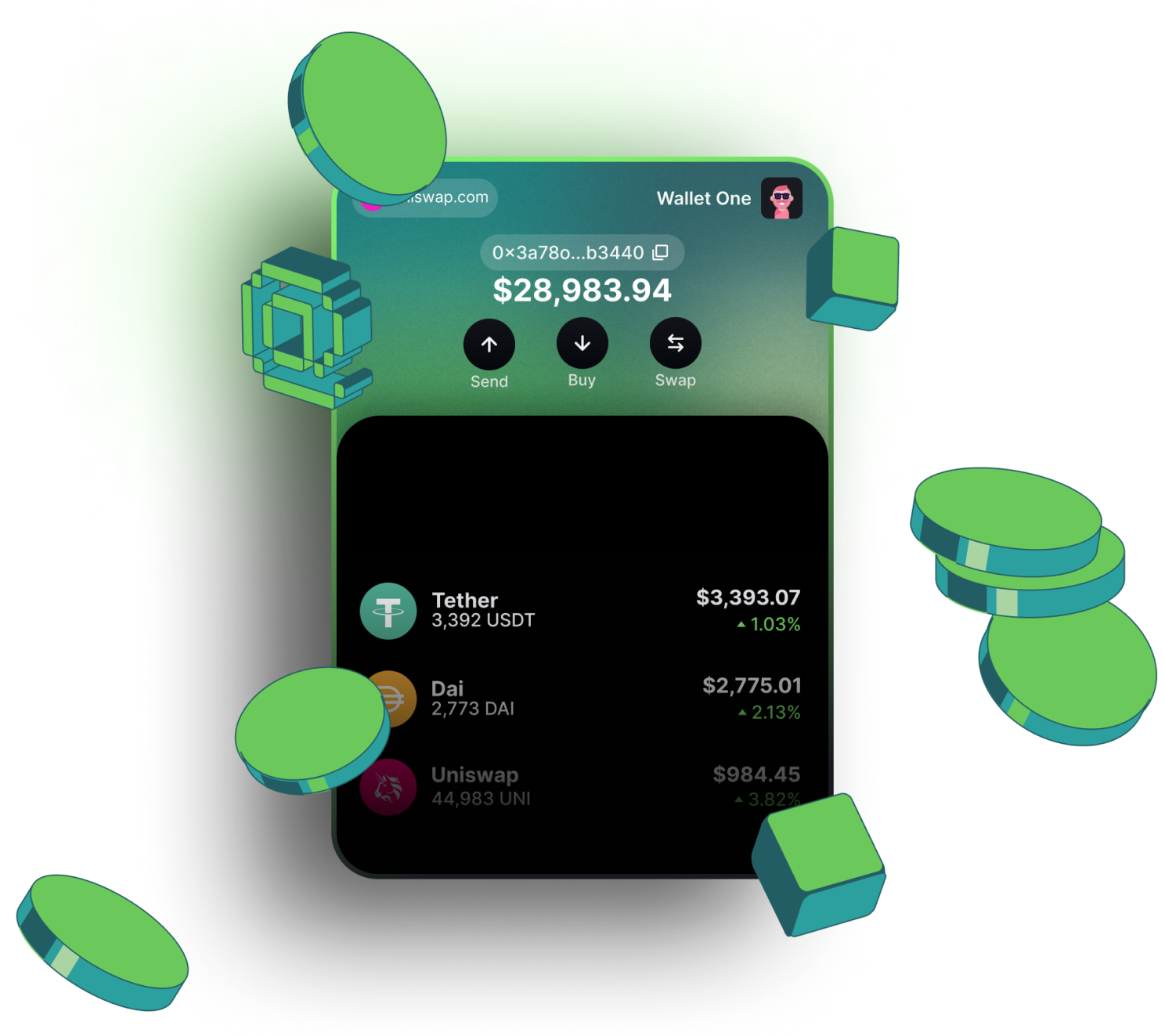Wigwam is the best  Moonbeam blockchain crypto wallet
Moonbeam blockchain crypto wallet
Download Extension
Why choose the Wigwam crypto app?
Work with Moonbeam Testnets and Mainet
Buy Moonbeam tokens, including native token, by using a credit card
Swap Moonbeam-based tokens directly in the wallet
Possibility to connect the wallet to all Moonbeam blockchain dAps: DeFi, DAO, Gamings, etc
How to get a Moonbeam address in Wigwam web wallet
Create a wallet in Wigwam
Choose a Moonbeam network from the dropdown menu
Copy you Moonbeam address
Moonbeam Blockchain review
Moonbeam is a smart contract blockchain made to unlock the true potential of blockchains as it allows for the building of connected applications, which are not limited to a single blockchain. Moonbeam has united the functionality of Ethereum, Cosmos, Polkadot, and many others into its single network and has opened the doors for unlimited opportunities and innovations.
Origins & Vision
Moonbeam was founded by Derek Yoo, the CEO of PureStake, in 2019. It was created as a secure public smart contracts-enabled blockchain infrastructure that helped developers build applications that operate across multiple blockchains.
Moonbeams allows developers to use popular Ethereum tools to build and deploy decentralized applications using the Solidity programming language and Substrate.
Key Milestones
Moonbeam’s first testnet called Moonbase Alpha went live in September 2020. Allowing dApp developers to test the network’s Ethereum compatibility and test dApps without spinning up their node.
After the deployment of Alpha, the Moonbase testnet underwent three further upgrades with some additional features in the same year.
Moonbeam launched a new collaboration with the Parity team and ported the Balancer Protocol in 2021 to grow its DeFi ecosystem with Balancer’s programmable liquidity.
Moonbeam partnered with SeaScape in 2021, to redeploy a version of their existing games based on Ethereum on their platform. SeaScape also started developing a game that would be exclusive to Moonbeam. To play these games you may use the Wigwam gaming wallet.
Moonbeam launched its native Glimmer (GLMR) tokens in January 2022. GLMR is the utility token in Moonbeam’s ecosystem.
What Consensus Algorithm Does Moonbeam Blockchain Use
Moonbeam is a parachain of Polkadot and it utilizes a Delegate Proof-of-Stake (DPoS) for collecting transactions and producing state transition proofs, and a GRANDPA protocol for reaching finality on its relay chain (Polkadot).
DPoS in Moonbeam is a consensus mechanism, in which token holders delegate to choose which collator candidate to support and to what degree. Moonbeam’s ecosystem has Collators, who maintain the ecosystem by collecting transactions and producing state transition proofs for the relay chain validators.
How Moonbeam Technically Solved Problems with Scalability, Decentralization, Speed
Moonbeam utilizes its hybrid consensus mechanism to solve the issues of scalability and speed. Collators collect the transactions and produce state transition proofs for the relay chain validators, which enable validators to process the transitions faster and finalize a block with high speed.
Moonbeam solved the issue of decentralization from the beginning as it was built with Substrate Connect, which allows the running of network light clients in the browser without needing centralized RPC services such as Infura. Substrate is also compatible with WASM.
Who are the Main Players in the Moonbeam Blockchain
In Moonbeam’s mixed consensus of DPoS and GRANDPA, validators, delegators, and collators play important roles.
Validators: In Moonbeam, validators process the transactions on the relay chain(Polkadot). They receive the collected transactions and state transition proofs from collators, which makes the validating process fast and faster finality
Collators: Collators collect the transactions, create state transition proofs, and forward them to the validators on the relay chain. In exchange for it, Collators earn rewards. Moonbeam requires users to stake their tokens as collateral if they want to become Collators.
Delegators: Moonbeam promotes more user interactions and decentralization by encouraging token holders to participate in the consensus protocol and share the rewards with the Collators.
DeFi Ecosystem on Moonbeam
Moonbeam is a cross–chain network, with Ethereum compatibility and allows users to easily build or redeploy Solidity projects in the Substrate environment. This interoperability attracts many users from Polkadot and other parachains.
Moonbeam’s DeFi ecosystem is quite diverse as it has decentralized exchanges like “SolarBeam”, “Piper Finance”, and “StellaSwap”. Lending protocols like “WePiggy”, “Prime Protocol”, and “Moonwell Arte”.
NFTs Marketplaces on Moonbeam
Moonbeam natively supports the ERC-721 NFT bridge with Ethereum and ERC-1155 standards leading to a variety of top-tier multi-chain NFT marketplaces to deploy on Moonbeam and giving users access to buy, sell, and exchange their NFTs.
Due to its multichain access, Moonbeam attracts a large diverse set of artists and collectors to mint and sell NFTs. “Tofu NFT”, “Treasureland”, and “MoonBeans” are some of the well-known NFT Marketplaces on the Moonbeam blockchain.
Tokenomics and Gas Usage on Moonbeam
GLMR is the native utility token of the Moonbeam ecosystem. It is used for paying gas fees, and transaction fees. A GLMR token holder has the power to shape the Moonbeam ecosystem as token holders can participate in the on-chain governance, and vote on various key decisions such as upgrades, vote for the council member, etc.
Conclusion
Moonbeam entered the blockchain universe with its innovative multi-chain access, uniting the functionalities of Ethereum, Cosmos, Polkadot, and many others into its single network and solving the fragmented user experience. Today Moonbeam is leading the way for true interoperability and shaping the next generation of multi-chain dApps.
FAQ
Enter your public wallet address into the search bar of the Moonbeam Chain (GLMR) Blockchain Explorer to view your wallet activities.
Glimmer (GLMR) is the native token of the Moonbeam chain, which is utilized for gas fees.
To store your GLMR tokens, you can use or a Polkadot-specific wallet, as tokens from Polkadot and parachains are not always compatible with Ethereum wallets due to their technology differences. Moonbeam uses Substrate and its ecosystem consists of various interconnected blockchains, hence specific wallets are tailored for its ecosystem ensuring security, compatibility, and efficient interaction within its unique multichain environment. Also, because Moonbeam is an EVM-compatible blockchain, you may use popular EVM wallets, like Wigwam Web3 wallet or Metamask.
According to DappRadar, “Moonwell”, “Beamswap”, and “Stellaswap” are the most popular DeFi projects. Moonbeam has popular gaming projects such as “Evrloot”, “Bit Hotel”, and “The Great Escape”.
Go to MetaMask, click on your profile at the top-right, and choose "Settings" from the dropdown list of options. Navigate to "Networks" and select "Add Network." Now select "Add a network manually" and to add Moonbeam, you can enter Moonbeam’s network configurations:
Network Name: Moonbeam
RPC URL: https://rpc.api.moonbeam.network
ChainID: 1284 (hex: 0x504)
Symbol: GLMR
Block Explorer URL: https://moonscan.io/
Save your changes by clicking the "Save" button and MetaMask will automatically connect to Moonbeam.





